Archive
Monthly Archives: August 2017
Monthly Archives: August 2017
The first few hours or days back at school are hectic. Timetables to give out, courses to enrol, books to organise. Annndd in my case – uniforms to check, planners to sign, and inevitability parents to call about incorrect shoes, hair, make-up, skirt length, nail varnish. We are busy: sorting out seating plans, handing out new books, sorting out target sheets and stickers, homework schedules, IEPs and TA resources.
Yup – back to school is hectic.
Added to this, most schools encourage a full-pelt return to hard learning. “What the learning question for your first lesson?”
Sometimes we just need a little bit of time.
For my new classes with older students – I like to gain 10 minutes or so with a few easy ‘get to know you’ activities.
Espresso Yourself – does that just that. Buys me 10 minutes to calm, followed by quality chat with the kids I have only just met. While I am muddling through the register and seating plan, they are telling me everything I need to know about them.

*I send emails with teaching tips, tricks, and free resources to my subscribers regularly. I value your privacy and you can learn more about how I handle your data in our private policy. You can unsubscribe at any time.

*I send emails with teaching tips, tricks, and free resources to my subscribers regularly. I value your privacy and you can learn more about how I handle your data in our private policy. You can unsubscribe at any time.

In my classroom, we spend a great deal of time analyzing language and techniques in literature. Often one we have read and discussed a text, my students are confident with their ideas. They have things to say about the language used, the structure, or the form. Yet they can struggle to put these ideas to paper.
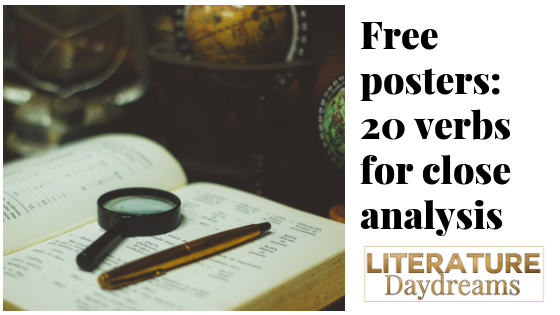
I avoid using sentence frames for literature essay writing whenever I can. They are hugely restrictive and it is boring to mark a whole set of essays that read the same.
One way to improve how close analysis is written up is to focus on the verbs of analysis. I have these 20 posters up in my classroom and I refer to them frequently. I also have them printed in a small task card size so students can have them on their desks.
These verbs not only help students focus their thinking and ideas, but also allow them to bring some variety to their analytical writing. We are avoiding the overuse of ‘this suggests’ and ‘this implies’!
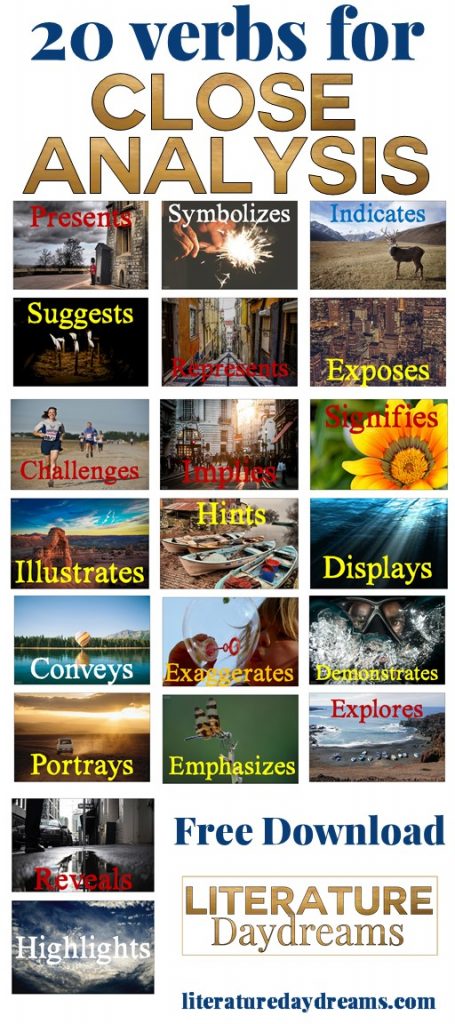
This list of 20 verbs is free for you to download here!
While you are here – consider signing up for my weekly newsletter. Every Sunday I send out two teaching ideas: one classroom activity, and one literature activity. You can sign up using the form below!
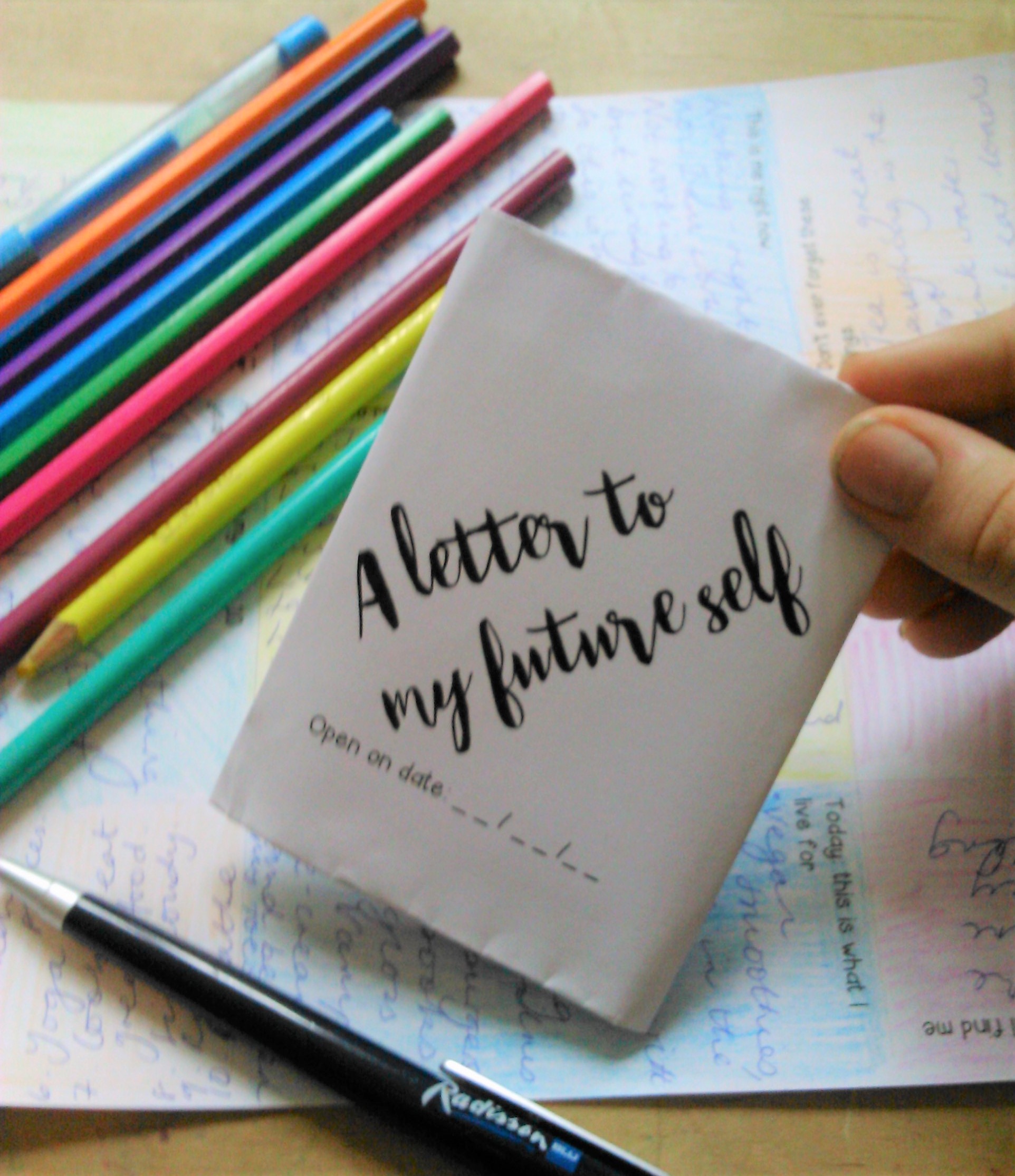
Sign up below to receive regular emails from me jammed packed with ELA teaching tips, tricks and free resources. Also access my free resource library!
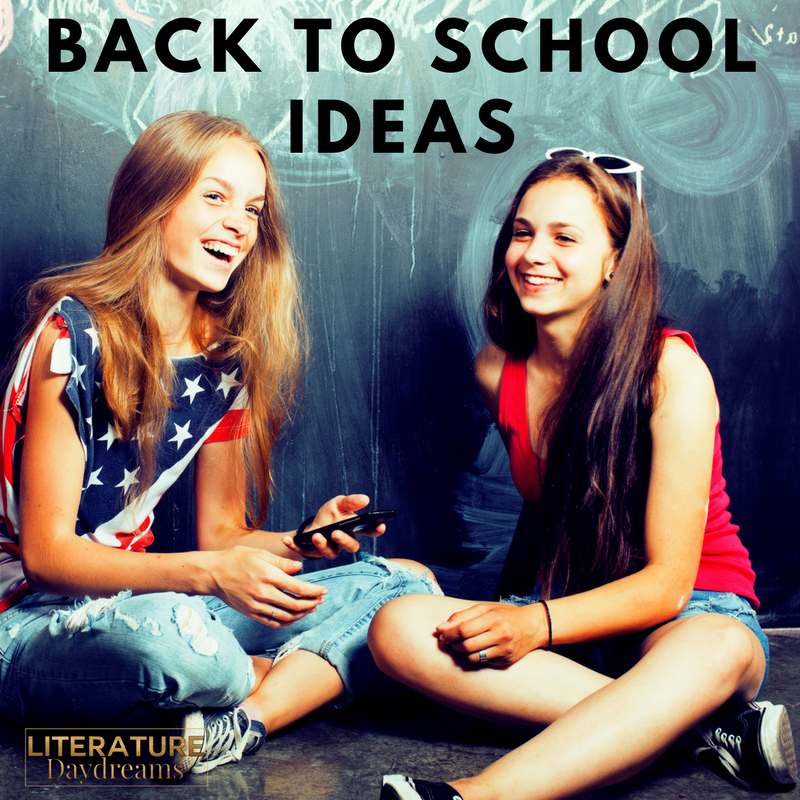
Hey teacher-friends!
This post is a sweet morsel from me to bring you a hamper full of ideas for Back To School. Sound good? Well, head on over to my IG account to find them there. Throughout the month of August, I am sharing my favorite classroom ideas igniting a spark in the classroom. Even better – I am sharing freebies and gifts as well, exclusively on IG. So let’s get connected!
That’s all for today but check back soon for my new series of blogposts on teaching Macbeth!

*I send emails with teaching tips, tricks, and free resources to my subscribers regularly. I value your privacy and you can learn more about how I handle your data in our private policy. You can unsubscribe at any time.
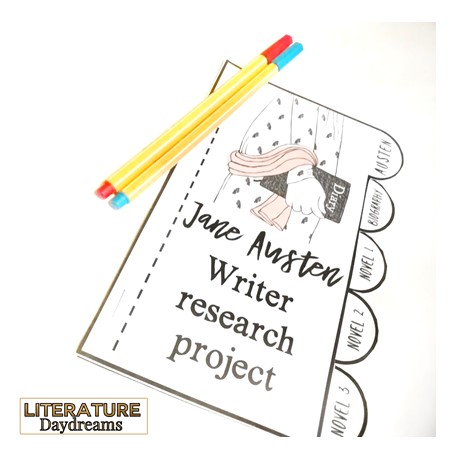
We all love a period drama don’t we? Well, you and I probably do. But your average teenager… Reading 19th century literature with classes presents us, as teachers, with a number of unique opportunities. It is at this moment that we are, probably, at our most multi-disciplinary. We are scientists – discovering electricity and inventing CPR. We are adventurers – seeking out the south pole and charting the North West Passage. We are theologians – struggling to believe in the Age of Enlightenment. We are historians – obsessed with the Classical Age, avoiding the present. We are politicians – fearing Revolution and rebellion. When I look at the 19th Century I see all the “old England” of smugglers, pirates, and highwayman and I also see all the “new England” of the factories, technology, and workhouses.
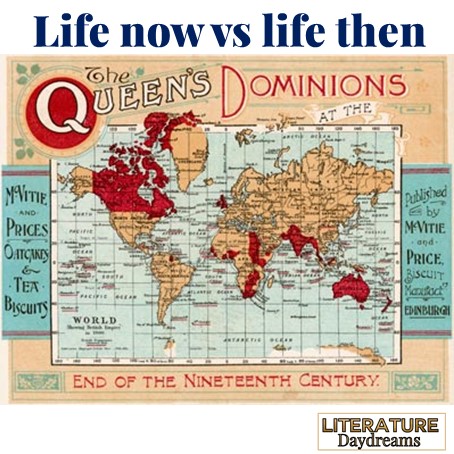 1. Starting at the beginning
1. Starting at the beginningBefore I even put a piece of 19th century literature in front of my students, I pose the question: “What is the difference between life today and life in 19th century?”. Generally, at first strike – I get only the obvious answers (people were dirty). The knowledge that my students have of history is limited. They can tell me loads about life in the workhouse, they can talk about factories. But beyond these specifics they are still in the dark. “History” says the historical novelist Dame Hilary Mantel “is what’s left in the sieve when the centuries have run through it”. The bits we pick out of the sieve to teach our younger students is pretty specific.
So what are the main differences we see:
Once we have made this list, it’s time to jump straight in and look at some writers. At this point – I might set my classes up with an author research study. Sometimes I find it is favourable for students to know in advance some of the historical and biographical details linked to a particular author. For Austen, Dickens, and Shelley, these are particular relevant.
We also tend to notice that while there are few narrative links between stories we read (A Christmas Carol -> Pride and Prejudice -> Frankenstein); we do come across the same ideas again and again. The abuse of power, the issues of social class, the treatment of the poor, the role of women in society. Each of these novels, in some way, speaks to these universal themes again and again.
Ok, so we’ve talked about the differences between now and then, we’ve met the author. We can’t put off reading the text any longer!
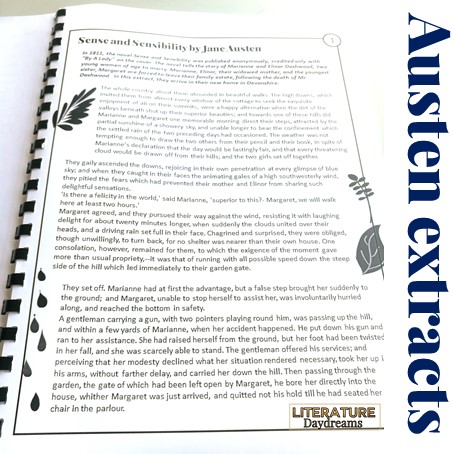
We also don’t always read full texts (shhhh don’t tell the writers!). There are some 19th century texts that our national curriculum and examination syllabi require us to study. But other than that we have free reign. However, given that many are 300+ pages and some have opening sentences that run to 100+ words, I don’t always decide to read entire novel. In fact this year, I have been teaching extracts only. Extracts from my favourite 19th century fiction and I have been BLOWN AWAY by the understanding shown by my students. This broad range has given them a far greater insight into this area of British Literature than if we had just focussed on one novel. The image above shows an extract from Sense and Sensibility that we love to study!
There are 5 skill areas that I cover when we read 19th century literature:
Developing comprehension of these extracts can take time. I don’t want to tell students what everything means, being reliant on the teacher in that way doesn’t help anyone. But – students need to know a whole bunch of stuff before they can even begin to grapple with the ideas and points of view presented in a text. For example: the language here is quite tricky. Marianne states “Is there a felicity in the world superior to this?” I kid you not when I ask classes about this sentence – they often think it is about a girl named Felicity. When we are reading we are trying to work out what is going and what can sometimes be hindered by our understanding of language. So comprehension of narrative and comprehension of language must go hand in hand.
Students are great at creating a general understanding of what is going on by themselves. They know that they won’t get it all straight away. So we do a 1-2-3 reading strategy.
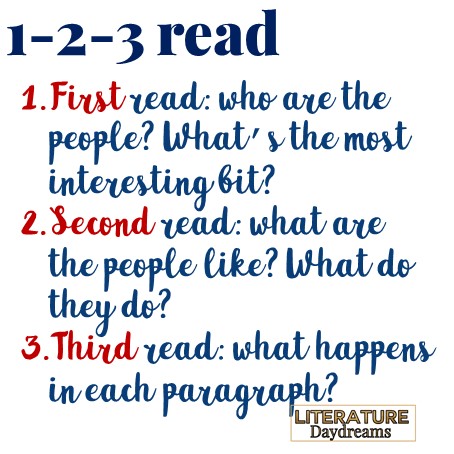
I start off by reminding students that a 500 word extract should only take about 2.5 minutes to read. I tell them, that because I love them and because it’s like “way old writing”, I’ll give them 3 minutes.
And what do you find? That despite not knowing what the word ‘felicity’ means – students have understood what happens in each paragraph. This particular extract from Sense and Sensibility is perfect for this exercise (and guess what – shhh – you can download it as a freebie here).
So now we know what is going on in the extract – we can flip back and do some word work. This is absolutely vital before we do any close analysis. It would be very easy to treat this as another dictionary task, but one issue with 19th century literature is the use of language that has slipped outside of everyday usage. Students need to grapple with these words for themselves before they can interpret another writer’s use.
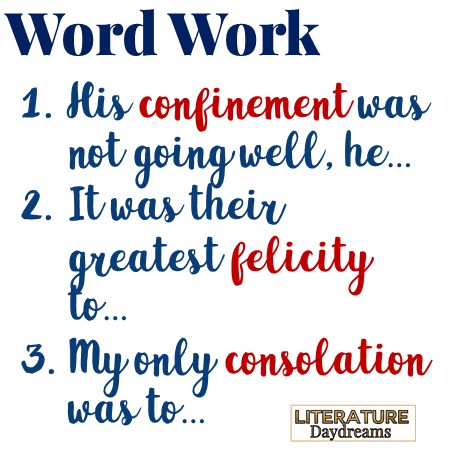
For me then this word work is 2 phrase: first the dictionary work to define and then second to use these new words (or reframed words) in their own writing. The examples above are sentence starters that I give students using the vocabulary. I do this because with this students are more likely to use language correctly with this additional support, than if asked to just come up with their own idea.
The final area we really focus on when studying 19th century literature is syntax and sentence structure. For us in the modern age, the event of modernism, saw a revolution in sentence structure. Authors rejected the highly embellished writing of their predecessors. Modern writers use shorter sentences and fewer clauses. Students can find reading the long sentence types seen in 19th century literature a challenge. So I turn it into a puzzle or a scavenger hunt.
By teaching the syntactical structures, such as polysyndeton, cumulative, and periodic sentences, students can make sense of what they are reading, and find ways to explain its purpose.
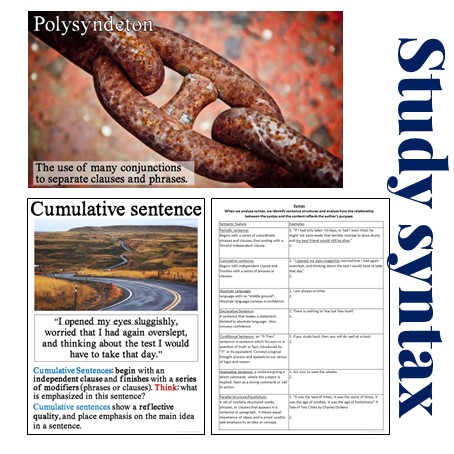 For my Maths and Science boys – literature becomes a literal puzzle, one that they can define, measure, and explain with more ease.
For my Maths and Science boys – literature becomes a literal puzzle, one that they can define, measure, and explain with more ease.
I hope these hints and tips will help you make 19th century literature come alive in your classroom. If you are interested in my resources to help deliver these ideas in your classroom please see the links below!
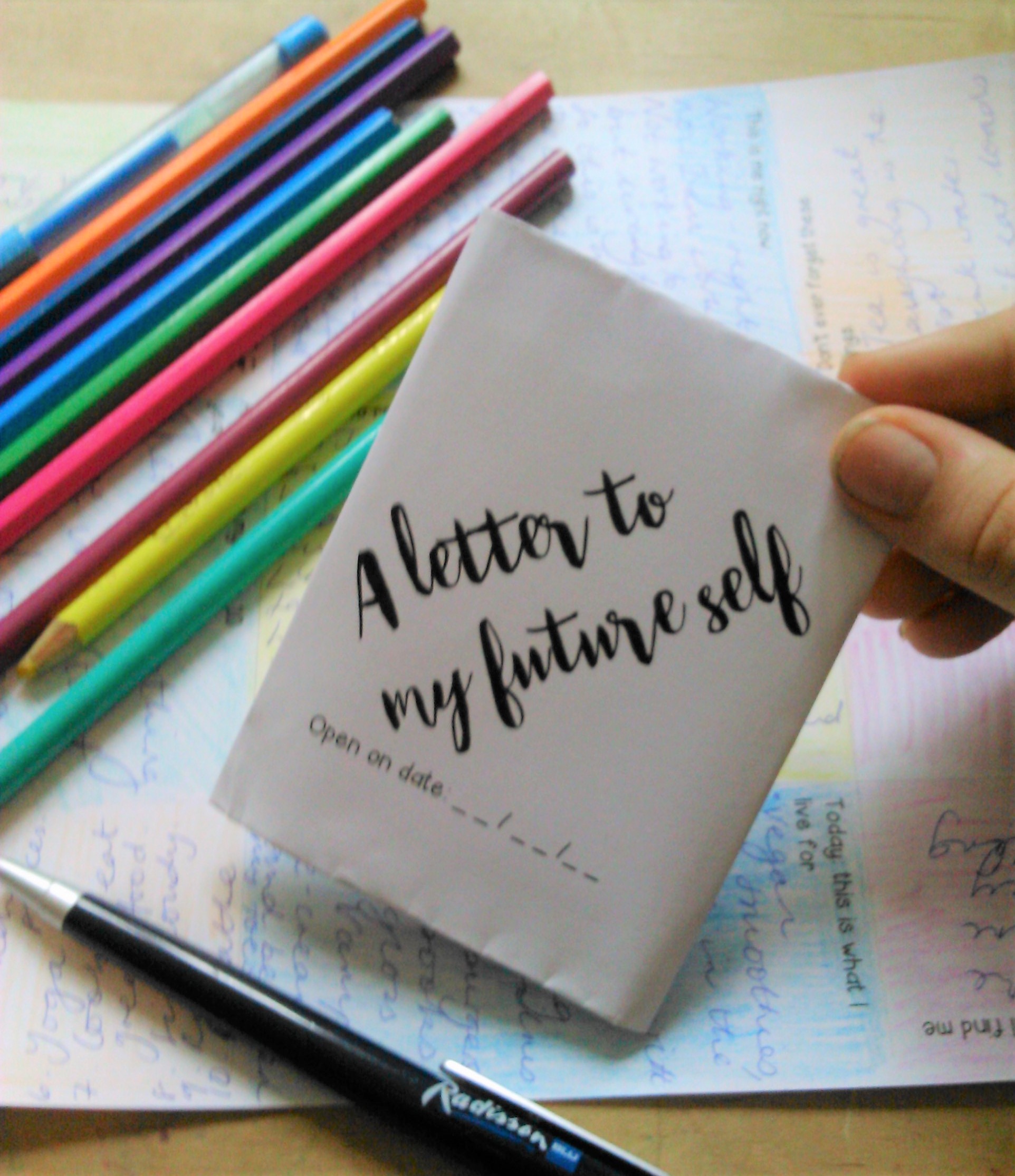
As the new school year approaches, I get a feeling – the same feeling I get every year – nervous and excited. I know that I will be meeting a bunch of new students: some I’ve never taught before, and some returning faces.
For each of these kids, I make a silent promise each September, that I will really see them. That I will take the time to get to know them. That they won’t fade into the background. That even though I will only see them 3 times a week (sometimes less) that they will be known in my classroom.
So I do all the usual stuff: learning names, memorising faces, greeting at the door.
Yet, it isn’t our classroom chat that helps me find out who these kids really are. It helps for sure. But there is something I do with my students that, every year, blows my mind without fail. It is to have them write me a letter. In fact to have them write me lots and lots of letters. A letter, a week for the first full term of school. That’s 13 letters, 13 chances for them to tell me the stuff that matters.
I love letter writing. It’s been ages since I’ve received anything more personal than a greetings card in the post. When I receive a letter, well, that’s something special. I like to tell kids about how when I left home, there were no mobile phones, no email or FB. I mean it was the 1990s, man! If we wanted to keep in contact with friends, who had moved to another part of the country, we had to write a letter. I moved to London. My best friend moved about 400 miles away to the Scottish borders. We would write to each other once a month – sometimes 10 sides of paper or more – I loved receiving those letters.
![]()
Letter writing, like diary writing, has been replaced by 140 characters or a fuzzy selfie. As letters are by their very nature personal – when we lose them, we risk losing a deep knowledge of human nature. Today we can watch fast-moving news events live. But what about the people involved a week later or a year later? Letters allow us time to reflect on our circumstances. If ever a species was in need of a pause button, it is humanity.
The first letter that my students write – is a letter to their future selves. Meh. You might say. Been there, done that. Well, this letter is something a little different. Perhaps because it isn’t a letter at all. I like to ease my students into the idea of writing me a few pages. It’s more a series of thoughts, or reflections, a collection of hopes and dreams.
We write this first letter in class. Students color in the different sections and then hilarity follows as I show them the complicated way to fold it up to make a ‘Renaissance folded letter’. I explain that paper and postage were very expensive in the 1600s-1700s. Envelopes would have been a huge waste. So people learned to write on every available space, except for the space with the address and the wax seal.
This moment has another purpose. We learn to laugh together. We learn to fail together. We become a team in this lesson.
After this first lesson, I set my students a letter-writing homework each week through September, October, November, and December. We have a few mini-sessions on the “Lost Art of Letter Writing” (start with a greeting etc) but other than that, this is one of the rare times my students get to do writing without overly structured input.
They do have a rubric, but I have to be hands-up-honest here and say, I don’t always mark their letters for grammar and spelling and stuff like that. I find myself thanking students for sharing something, more often than not I find myself asking questions, wanting to know more. At this point for me, these are more than marks on the grade sheet. And my kids need to know that.
There is no topic I won’t set, and depending on the age group of my class, we have covered them all. From ‘what is love’ to ‘my best day out’. From ‘is Britain a dystopia?’ to ‘is free speech really a good thing?’. Students know the letters that are set for them to think through a particular topic. To express their beliefs, opinions, and whatever muddle comes in between. Many times a student will start out with “I believe…” and by the end, they have found some different thoughts.
While I am being honest, I also what to tell you about the unexpected and awesome benefits of these letters. These were totally unplanned by me when I was developing this idea. First off, my students are more confident to express their ideas and opinions in my classroom. Yay! Less tumble-weed and more “I’m waiting for quiet!” but in an ELA classroom debate, discussion, and ideas are at the heart of what we do. Second, I discovered these kids are funny and clever and may does that give me hope for the future. (This one probably should have been first up). Last but by no way least, my students are better writers. And that’s my day job. These letters push them to think on topics they don’t really think about and they are improving in their writing and their expression for it.
So my advice – get your students writing letters. If you are interested in using this idea in your classroom. Click the image below.